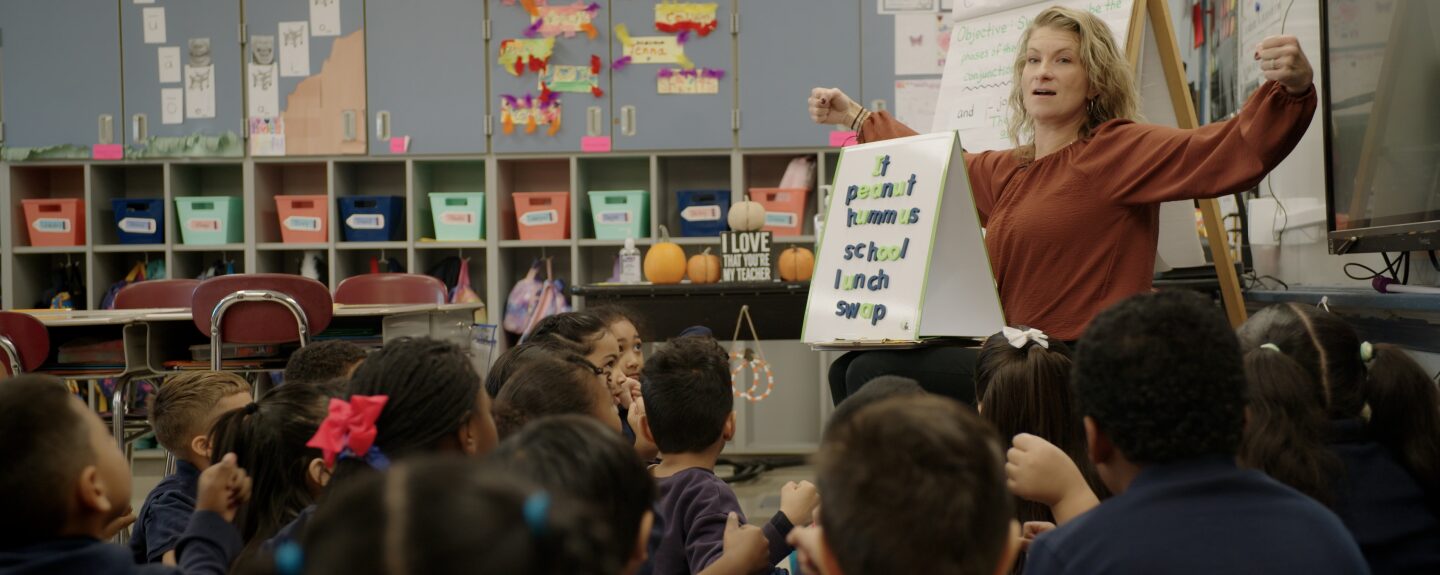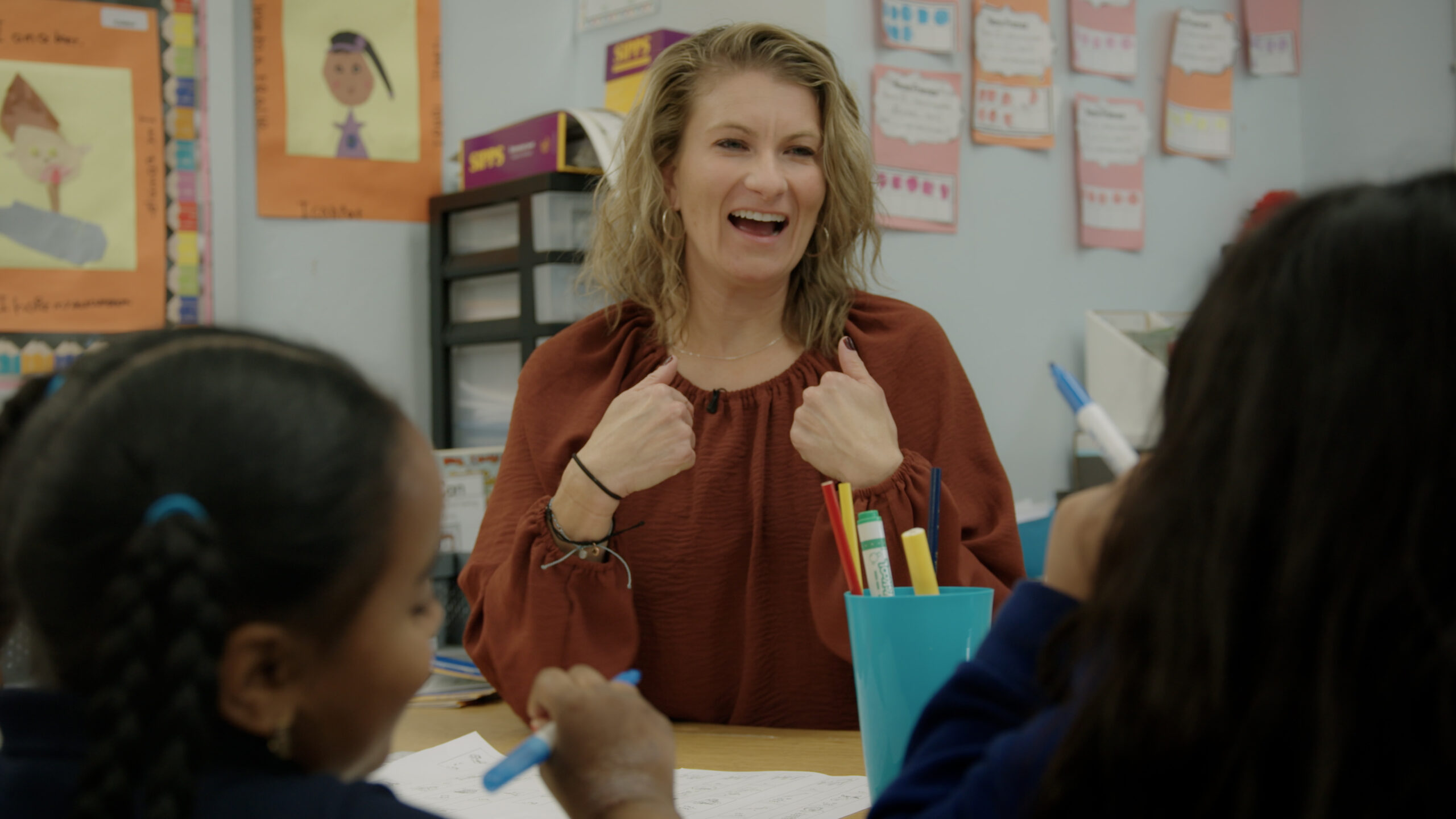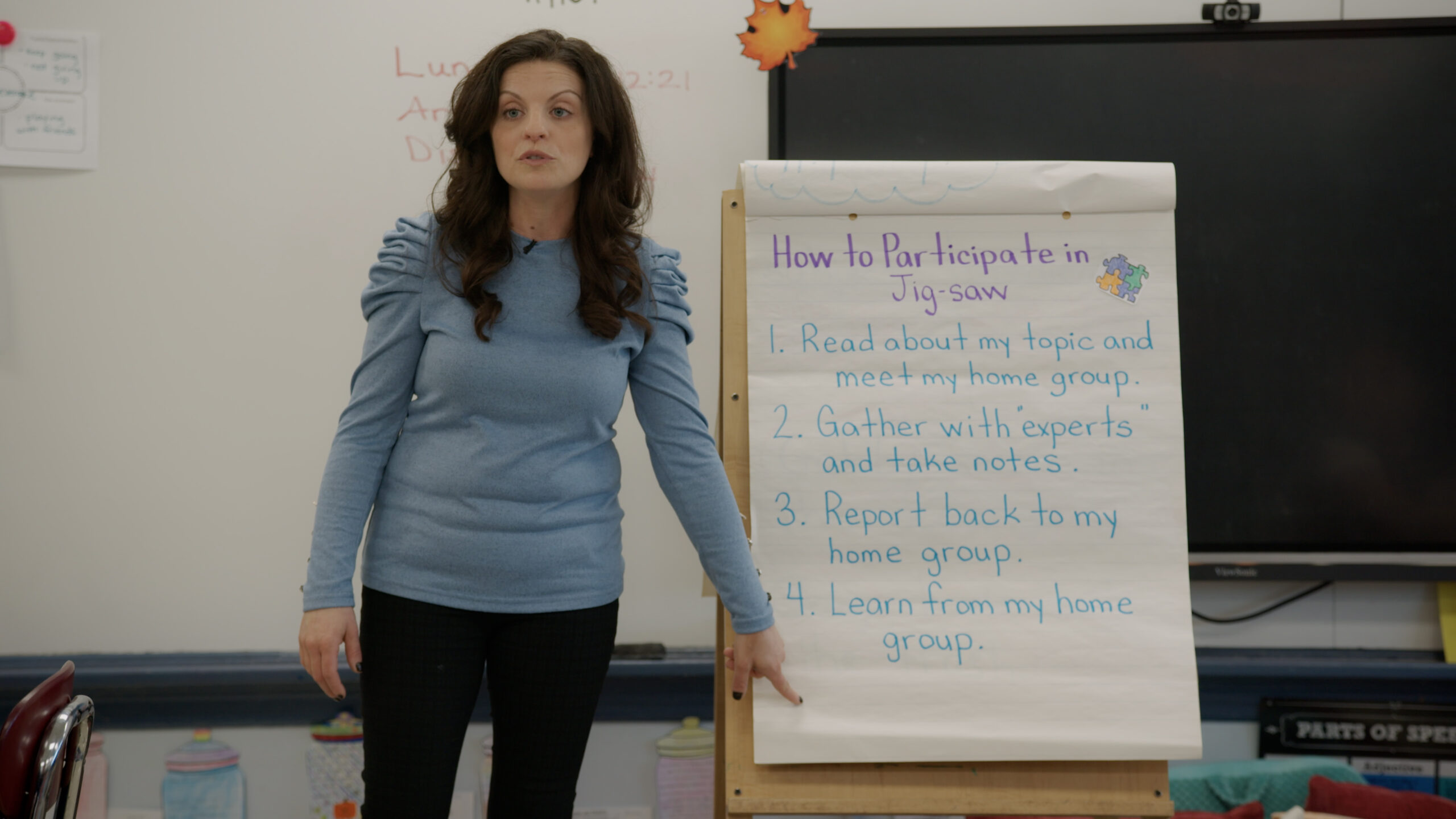
Science-Based Reading Instruction
Explore teacher-led, classroom videos focused on the concepts of effective literacy instruction including word recognition, comprehension, vocabulary, and fluency!
Jump to a Category:
Building Readers’ Word RecognitionStrengthening Language ComprehensionDeveloping Vocabulary-Rich InstructionCreating Fluent Reading
Building Readers’ Word Recognition

Blending Practice
Build Phonemic Awareness
This video demonstrates sound-by-sound and continuous blending techniques in a straightforward and applicable manner. It then illustrates segmentation using words to highlight the reciprocal relationship of phonemes. Understanding the 26 letters and 44 phonemes and pronouncing them accurately is crucial for supporting students in making connections between phonemes and graphemes.

Wordplay: Phoneme Manipulation
Build Phonemic Awareness
The teacher conducts phonemic awareness activities at the sound wall to manipulate phonemes of familiar words to reinforce decoding skills and gather informal data on student understanding.

Introducing an Explicit Phonics Lesson
Components of an Explicit Phonics Lesson
In Part 1 of the explicit phonics instructional components, the teacher states the goal and purpose and reviews familiar phonemes and graphemes preparing students for the next new sound-symbol relationship. During this review time, the teacher assesses student understanding as they engage in a familiar routine of listening, speaking, and using gestures while they recite each sound.

Guided Practice During an Explicit Phonics Lesson
Components of an Explicit Phonics Lesson
In Part 2 of the explicit phonics instructional components, the teacher introduces a new concept (sound and letter pattern) to students and models pronunciation and expectations. This portion of instruction is often referred to as the “I do.” Next, the students are guided and supported as they work collaboratively to match words to the beginning letter/s. During this guided practice time, the teacher observes and monitors students while providing in-the-moment feedback. This portion of instruction is often referred to as the “ We do” and prepares students for the “you do,” or independent practice.

Dictation and Word Meaning in an Explicit Phonics Lesson
Components of an Explicit Phonics Lesson
In Part 3 of the explicit phonics instructional components, the teacher conducts a daily dictation practice on whiteboards with students to observe which sounds and letters are mastered and which ones may need more review. Next, we see the teacher providing brief, student-friendly definitions for a set of words. The students engage in partner discussions and gestures showcase word meaning. In the final segment, the teacher meets with a targeted small group of students to connect new sound patterns to a controlled text.

Introducing High-Frequency Words
Leveraging High-Frequency Words
In this video, the teacher practices a routine to introduce high-frequency words using elkonin boxes to map out the sounds of the letters.

High-Frequency Word Instruction: Reinforcing Sight Word Recognition
Leveraging High-Frequency Words
In this video, the teacher is focuses on teaching high-frequency works in a systematic way. First, a list of previously introduced high-frequency words are reviewed. Next, students identify the words as the teacher reads the morning message. Then, meaning is given to the function words as students practice writing the words using their whiteboards.

Physical Phoneme Segmentation
Instructional Sequence of Spelling
In this video, students physically tap out word sounds on their arms. The teacher uses total physical response, visual cues, and interactive methods for learning new words. The words of study connect meaningfully to the topics, themes, and texts read.
Strengthening Language Comprehension

Teacher Clarity
Intentionally Planning Language Objectives
In this video the teachers instruction highlights the importance of language objectives, especially when supporting multilingual learners in the classroom. The teacher uses data to plan for language and skill development that will take place during the lesson. Opportunities for speaking, listening, reading, and writing are prioritized.

Analyzing Nonfiction with Predictions
Building and Activating Background Knowledge
This video showcases the instruction during a class read. The teacher supports students in building content knowledge by coming up with predictions and determining if the predictions are confirmed after reading the chapter together. The teacher uses opportunities for partner discussion and encourages students to provide evidence from the text to support their claims.

Introducing Think Alouds through Sentence Starters
Modeling Think Alouds
In this video, the teacher introduces and models think-aloud using the sentence starter “I’m getting the sense that…” with a familiar text during a class read. Students are prompted to practice the think-aloud strategy with partners and share their thinking with the group. Students are then encouraged to continue practicing during independent reading.

Combining Sentences with Conjunctions
Using Writing to Support Comprehension
The teacher models how to connect a text to sentence writing to build content knowledge in tandem with other skills, such as understanding sentence structures and syntax. The teacher models using a set of conjunctions to combine sentences with topics connected to a familiar text. The students then practice the skill with partners while the teacher provides support and feedback.

Create topic sentences to Find the Main Idea
Using Writing to Support Comprehension
The teacher defines and identifies a topic sentence and supporting details while modeling with a familiar text in a targeted, small group format. As the details of the story change, the students turn and talk to discuss a topic sentence that describes the paragraph’s main idea. The teacher then connects the reading to writing as the group writes a new topic sentence together while practicing decoding and phoneme/grapheme connection.

Using strategies in combination: The Jigsaw method
Teaching Comprehension Strategies through Content
The teacher uses a jigsaw method to practice comprehension strategies interactively through reading a nonfiction text connected to their current thematic unit. The students are supported with step-by-step instructions and graphic organizers and are guided in thinking, speaking, and writing in response to their reading. Groups of students are responsible for reading a manageable section of the text, taking notes, and acting as “experts” to retell and teach notable facts to their teams.

Using Questioning to Support Comprehension
Teaching Comprehension Strategies through Content
In this video, the teacher works with a small group of students to practice using questioning using visual sentence starters. The students practice asking questions out loud to the group as they review a familiar text, a picture book version of a class-read chapter book. The teacher reinforces how asking questions aids in deepening understanding of the story and uses a puppet to spark engagement and make thinking visible during the lesson.

Tier Two Vocabulary Words: A Coaching Conversation
Teaching Comprehension Strategies through Content
In this video we witness a one-on-one literacy instructional coaching session. The discussion shows how to choose tier 2 words from an instructional text. The teacher uses instructional level texts 2-3 grade levels higher for interactive read-alouds and identifies tier 2 words to teach explicitly.
Developing Vocabulary-Rich Instruction

Previewing vocabulary words with student-friendly Definitions
Selecting and Using Appropriate Vocabulary Words
The teacher provides brief, student-friendly definitions of pre-determined vocabulary words before a digital read-aloud of a text connected to their current thematic unit. Students are prompted to pronounce each word and practice a variety of activities such as talking to partners and acting out the meaning of the words.

Vocabulary-Enriched Messages: Using Word Maps
Selecting and Using Appropriate Vocabulary Words
The teacher embeds vocabulary into the morning message that considers students’ social, emotional, and academic needs and connects to their current reading unit. The teacher pauses to provide brief, student-friendly definitions to bolded, pre-identified words to support understanding of the message. Re-reading the messages for fluency and expression builds fluency, while extension activities, such as using a graphic organizer, reinforce reading foundational skills.

After Reading: Vocabulary Engagement
Specific Word Instruction
The teacher models activities for engaging with the tier 2 vocabulary words and engages in a text talk routine focusing on the word “poisonous.” The teacher provides multiple opportunities for students to pronounce the word and respond to prompts and examples illustrating the word’s meaning. The students are also given opportunities to discuss their thinking with others.

Tools for Vocabulary Acquisition
Specific Word Instruction
The teacher models a routine for focusing deeply on a vocabulary word by breaking down the word pronunciation, discussing word origin, discussing a simple meaning, and connecting to sentence writing. The students work in partners to co-create and independently write sentences using the tier two vocabulary word.

Suffix Discovery
Using Word Parts to Support Instruction
The teacher models Identifying word parts and meanings of a base word and suffix using a vocabulary word from a familiar text. The students discuss words with the same suffix with partners and the group comes together to determine the meaning of each word in student-friendly language.

Multisyllabic Words
Using Word Parts to Support Instruction
The teacher models breaking apart multisyllabic words by syllable. The students pronounce each syllable as the teacher visually connects each sound to the word part. After the students practice saying and clapping out the syllables for each word, the teacher provides a simple, student-friendly definition while connecting the word to a familiar text. The practice concludes with games as the teacher gives the students clues and they whisper the answer to their partners.
Creating Fluent Reading

Fun Fluency Drills
How to Support Speed and Accuracy
The teacher supports students by modeling how the text is read and using echo reading as the students practice reading a familiar text with partners. The focus is on accuracy and prosody to build fluency.

Read Like You Talk
How to Support Prosody, Intonation, and Expression
The teacher models make meaning and identify with characters through tone using portions of dialogue from a familiar text. The teacher and students discover the emotion behind the character’s dialogue and identify keywords and punctuation that provide clues to read with prosody.
